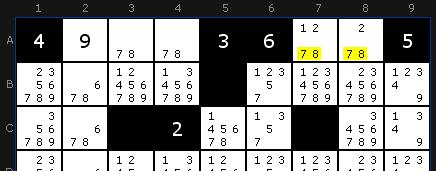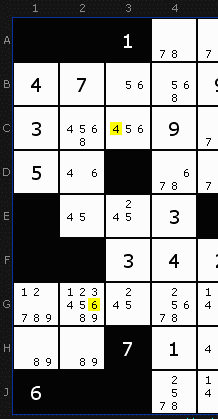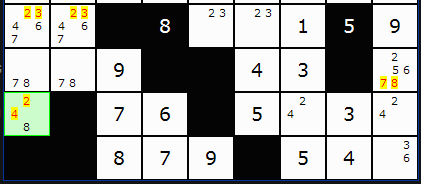Str8ts Strategies
Most of the Str8ts puzzle is about identifying the next cells that can be deduced from the clues in the black and white cells. On the easier puzzles this can be eye-balled - that is by scanning the rows, columns and the 'compartments' you should be able to find several opportunities to solve a cell. On the harder puzzles you might need to make notes in some cells to remind you of the the options.
Both the Str8ts Player and the Str8ts Solver have the ability to type in small number notes. In the solver these are always displayed but they can be edited as well.
For the purposes of outlining the strategies for Str8ts I am going to follow the list on the solver.
Solving Sequence
Start solving a Str8ts by working the smaller compartments ( 1, 2, 3 or 4 spaces) first. Using all the rules and clues and strategies listed below, the smaller compartments are simply easier to solve. Once solved, these smaller compartments start to fill in portions of the longer straights, and the filled in numbers remove themselves in rows and columns as possible numbers from the larger straights. By adding additional numbers to the puzzle we essentially are turning larger straights ( 5, 6, 7, 8 and 9 spaces ) back into manageable compartments that will be easier to solve. Especially if the following hands on strategies are used.
Compartment Check
Both the Str8ts Player and the Str8ts Solver have the ability to type in small number notes. In the solver these are always displayed but they can be edited as well.
For the purposes of outlining the strategies for Str8ts I am going to follow the list on the solver.
Solving Sequence
Start solving a Str8ts by working the smaller compartments ( 1, 2, 3 or 4 spaces) first. Using all the rules and clues and strategies listed below, the smaller compartments are simply easier to solve. Once solved, these smaller compartments start to fill in portions of the longer straights, and the filled in numbers remove themselves in rows and columns as possible numbers from the larger straights. By adding additional numbers to the puzzle we essentially are turning larger straights ( 5, 6, 7, 8 and 9 spaces ) back into manageable compartments that will be easier to solve. Especially if the following hands on strategies are used.
Compartment Check
If you are making notes or using the solver you can immediately eliminate 1,2,3,4 and 9 from those cells since they can never reach the clues we know about.
Fortunately we have another clue in this example. The 6 tells us the rightmost X can't be a 6 so it must be a 7. That allows us to put the 6 between the 5 and 8.
When you are considering a straight you need to check the rows and columns for any useful numbers. If they exist elsewhere then they cant belong to any cell the number can 'see' in the compartment.
Black cell clues are interesting since they can cut the options in half. Say you had a black cell with '5' and it intersected a compartment such that it saw all the cells in the compartment. Let us also say the compartment is four cells long. Now, because 5 is slap in the middle this compartment of four can only be 1/2/3/4 or 6/7/8/9. If you have a known you can decide which. So black cells, along with existing clues and solved cells will help pin down the remaining options.
In the solver, all the known numbers and the black cells clues are taken into consideration, as is the length of each compartment and the remaining possibles are computed. Usually this will find one or serveral cells for which there is only one remaining number. As a human, pencil and paper solver, you will not be able to pick out these opportunities as quickly but that's the fun of this puzzle, searching for the right combination of clues to get the next cell.
Stranded Digit
Black cell clues are interesting since they can cut the options in half. Say you had a black cell with '5' and it intersected a compartment such that it saw all the cells in the compartment. Let us also say the compartment is four cells long. Now, because 5 is slap in the middle this compartment of four can only be 1/2/3/4 or 6/7/8/9. If you have a known you can decide which. So black cells, along with existing clues and solved cells will help pin down the remaining options.
In the solver, all the known numbers and the black cells clues are taken into consideration, as is the length of each compartment and the remaining possibles are computed. Usually this will find one or serveral cells for which there is only one remaining number. As a human, pencil and paper solver, you will not be able to pick out these opportunities as quickly but that's the fun of this puzzle, searching for the right combination of clues to get the next cell.
Stranded Digit
Another way to look at it is this. Write out all the remaining numbers available in a compartment. If there is a gap - then only the numbers before or the numbers after the gap can be the solution to all the cells. Does this help you remove some candidates?
Lets take this small section and see how it plays out:
The 7 forces the 6 to the right. Above the 7 the 9 is too far away from 7 to be used - so 8 must fit there. 6 is disallowed because of the black cell clue above. And finally we can insert 7 into the last cell (marked in green).
The 7 forces the 6 to the right. Above the 7 the 9 is too far away from 7 to be used - so 8 must fit there. 6 is disallowed because of the black cell clue above. And finally we can insert 7 into the last cell (marked in green).
Stranded Sequence
Basically this extended Stranded Digit to a set of numbers that cannot form the compartment because there are not enough of them to cover all the cells. On the other side of the gap will be a second set of numbers which will have the ability to straddle the whole compartment.
Basically this extended Stranded Digit to a set of numbers that cannot form the compartment because there are not enough of them to cover all the cells. On the other side of the gap will be a second set of numbers which will have the ability to straddle the whole compartment.
Compartment High/Low
Here we look at all the available numbers in the compartment and determine if the minimum and maximum can be used given what we already have. Works best when the range can be pinned down with some clues or solved cells. Unlike the strategy below this looks in a single compartment at a time and is therefore slightly simpler.
Here we look at all the available numbers in the compartment and determine if the minimum and maximum can be used given what we already have. Works best when the range can be pinned down with some clues or solved cells. Unlike the strategy below this looks in a single compartment at a time and is therefore slightly simpler.
High/Low Str8ts
I've added this strategy thanks to feedback from solvers. I'm not sure what a good name is, but it has to be short to fit on the solver list. This strategy looks a two compartments in the same row or column. If there are some clues or solved numbers in a compartment often we can predict what the minimum and maximum necessary numbers will be for the entire compartment - based on the principle that a 'straight' is going to contain a sequence with no gaps. We dont need to now the exact straight - sometimes only the middle numbers of the straight can be predicted. But whatever range we can be sure of - these numbers can be eliminated from the other compartment in the row or column. Some examples:
I've added this strategy thanks to feedback from solvers. I'm not sure what a good name is, but it has to be short to fit on the solver list. This strategy looks a two compartments in the same row or column. If there are some clues or solved numbers in a compartment often we can predict what the minimum and maximum necessary numbers will be for the entire compartment - based on the principle that a 'straight' is going to contain a sequence with no gaps. We dont need to now the exact straight - sometimes only the middle numbers of the straight can be predicted. But whatever range we can be sure of - these numbers can be eliminated from the other compartment in the row or column. Some examples:
New Mid Section - Edit This


A couple of more subtle examples:
Looking at the column 2 first, we have a 4-cell straight with a known 7 in it. Now the widest possible range of numbers starts from {4,5,6,7} and goes to {6,7,8,9}. Its not even necessary to have the remaining candidates viewed to see the usefulness of this. The overlap of these two sets is {6/7}. We can predict that whatever the straight, 6 and 7 will be part of it. 7 is know so we can remove the 6 from the other compartment.
In a similar manner, the 3 in column 3 gives as ranges from {1,2,3} to {3,4,5}. But! 1 is already a black cell clue, so the minimum range is actually {2,3,4}. The overlap is therefore {3,4}, so 4 can be removed from C3.
There is a great deal of overlap between high/low and Stranded Digit and I'm not sure what to present first. The problem is that many fewer examples of 'high/low' will be found by the solver because Compartment Check and Stranded Digit are checked first, but if you are aware of the strategy it will be very useful. It also seems to get results more at the beginning of the puzzle than the end, as the min-max ranges are greater.
Required Digits
Within a compartment it may be possible to determine the minimum and maximum range of possible digits. For example, a compartment of length three may have the range of 6/7/8/9. Since the compartment has a length of three the compartment will have either 6/7/8 or 7/8/9 as the final solution (in whatever order). The overlap of 6/7/8 and 7/8/9 is 7 and 8. These are the Required Digits (or "sure digits").
If you know what the Required Digits are for a compartment then you can remove those candidates from any other compartment in the same row or column as the compartment you are looking at.
Also, it maybe the case in some circumstances that a Required Digit occurs in only one cell of the compartment. If that is the case - because it is 'required' and only found in one cell, it must be the solution to that cell.
Within a compartment it may be possible to determine the minimum and maximum range of possible digits. For example, a compartment of length three may have the range of 6/7/8/9. Since the compartment has a length of three the compartment will have either 6/7/8 or 7/8/9 as the final solution (in whatever order). The overlap of 6/7/8 and 7/8/9 is 7 and 8. These are the Required Digits (or "sure digits").
If you know what the Required Digits are for a compartment then you can remove those candidates from any other compartment in the same row or column as the compartment you are looking at.
Also, it maybe the case in some circumstances that a Required Digit occurs in only one cell of the compartment. If that is the case - because it is 'required' and only found in one cell, it must be the solution to that cell.
Naked Pairs
These is some cross over from Sudoku in this puzzle. Since rows and columns have the same rules as Sudoku they have some of the same strategies. The simplest is Naked Pairs. If two cells on the same row or column have the same two candidates - such as 1/6 and 1/6 - then we can be sure that 1 and 6 will appear in both those cells. We just can't be certain which way round yet. But that is extremely useful. If 1 and 6 are bound to be on those cells then any other 1 or 6 can be removed from that row or column.
The Naked Pair acts like a single cell clue - but make sure you apply it to only the row or column common to both cells. The two cells need not be next to each other or in the same compartment.
These is some cross over from Sudoku in this puzzle. Since rows and columns have the same rules as Sudoku they have some of the same strategies. The simplest is Naked Pairs. If two cells on the same row or column have the same two candidates - such as 1/6 and 1/6 - then we can be sure that 1 and 6 will appear in both those cells. We just can't be certain which way round yet. But that is extremely useful. If 1 and 6 are bound to be on those cells then any other 1 or 6 can be removed from that row or column.
The Naked Pair acts like a single cell clue - but make sure you apply it to only the row or column common to both cells. The two cells need not be next to each other or in the same compartment.

Naked Triples
This is the same strategy as Naked Pairs except we are considering three cells, not two. For example, if 1/3/6 was present in three cells we know that 1,3 and 6 must be found in those cells – we just can’t know which way round at this point. So any other 1, 3 or 6 in the row or column can be discounted.
The trick with Naked Triples is that we don’t need all three numbers to appear in all three cells. Consider three cells with these numbers:
[1,3], [1,6] and [3,6]
Think of any combination from these pairs and you will always use up all three numbers in those cells. The rule really is – “If any three cells contain at most three numbers – then those numbers can be removed from the rest of the row or column”.
This is the same strategy as Naked Pairs except we are considering three cells, not two. For example, if 1/3/6 was present in three cells we know that 1,3 and 6 must be found in those cells – we just can’t know which way round at this point. So any other 1, 3 or 6 in the row or column can be discounted.
The trick with Naked Triples is that we don’t need all three numbers to appear in all three cells. Consider three cells with these numbers:
[1,3], [1,6] and [3,6]
Think of any combination from these pairs and you will always use up all three numbers in those cells. The rule really is – “If any three cells contain at most three numbers – then those numbers can be removed from the rest of the row or column”.
There are bound to be further strategies and I don't pretend to have exhausted them all on this one page. Some will be borrowed from Sudoku - I can think of Hidden Pairs and Triples, for example, and some will be unique to Str8ts.
If you find a new strategy and want to share it with others we'd be delighted to explain it here and credit you with the discovery.
Happy solving!
Andrew Stuart








Comments
... by: Ali
I used it today in puzzle #5210. In column #8, at one point row #1 can be 2 or 4 and row #2 can be 1 or 3. Row #9 can be a 4 or 6. But since the solution must be unique, row #1 must be a 4, otherwise in the final solution row #9 can still be either 4 or 6.
Is this valid logic, or does it maybe fall into one of the other strategies? Or is it too simple to even count as a strategy?
https://www.slideshare.net/slideshow/str8ts-basic-and-advanced-strategies/8426761